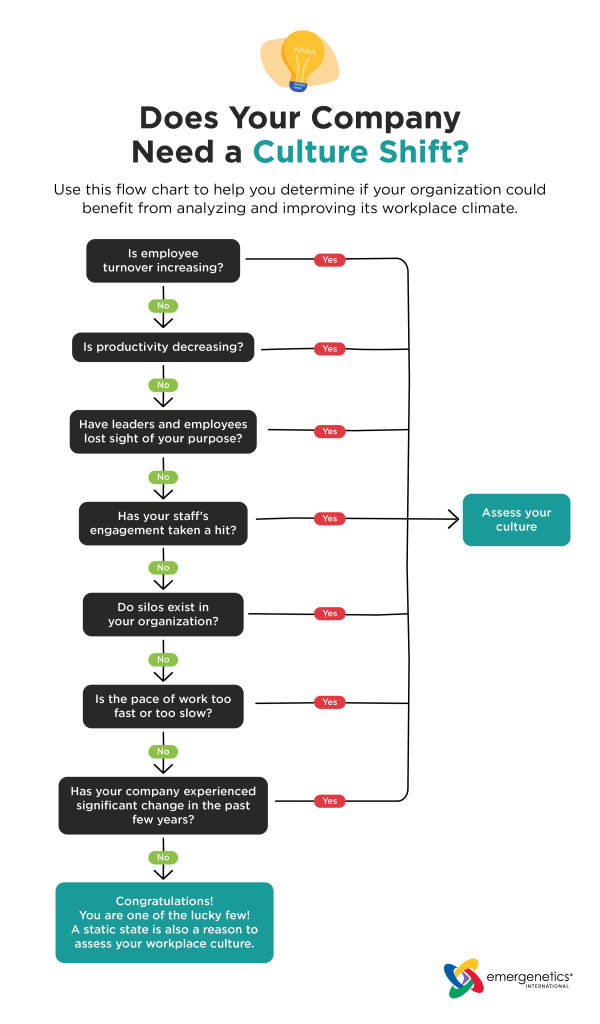
As the Great Resignation continues to grab headlines, company culture is coming into focus as a driver of employee retention and acquisition. Even if your business has not been impacted by significant turnover, your workplace climate matters. With more people seeking new job opportunities, your organization could benefit from an influx of fantastic talent.
If you want to hire and keep great team members, I invite you to evaluate your culture and assess if it’s time to make any shifts to better appeal to your existing and potential employee base. To get started, reflect on the questions below to understand if your organization could benefit from a more people-centric approach.
#1 – Is employee turnover increasing?
Let’s begin with one of the clearest signals that your environment could improve: retention. While some turnover is normal, study the data to analyze your retention rates year-over-year. Evaluate any changes and take note if turnover has increased since 2019. These fluctuations can be a major indicator that your staff is looking elsewhere and that your employee experience may not be as compelling as you would hope.
#2 – Is productivity decreasing?
There are many reasons why a business may experience variations in productivity, and not all necessarily reflect culture. For example, market demand could impact outcomes. However, it is important to explore the reasoning behind any reductions. You may find that people are not receiving the training they require to be successful. Motivation could be dipping, or workplace stress could be increasing. By analyzing the causes of a decline, you can better understand if your climate needs attention.
#3 – Have leaders and employees lost sight of your purpose?
Over the course of a challenging few years, many organizations have concentrated solely on survival. While that is understandable, the Great Resignation is teaching companies that most people want to contribute to a business that is doing good in the world and making an impact. If your firm has not recentered its focus on the purpose behind your work – or if it has never developed a compelling vision that celebrates more than profit – it may be time to prioritize culture.
#4 – Has your staff’s engagement taken a hit?
Motivation and employee engagement are typically strong indicators of the health of your corporate environment. When your people are not overly enthusiastic about their projects, role or future at the company, it is often a reflection of their own uncertainty about their place in the organization, the climate they are operating in or the business’s long-term potential – all of which relate to your ethos.
#5 – Do silos exist in your organization?
Each person in your company plays a role in the success of the organization, so it’s essential that they can cooperate effectively. Yet, in certain cases, individuals or teams may feel isolated from decision making and collaboration. In other instances, gaps may show up in the form of information inequities. When discrepancies in communication and connection grow, it can drain people and leave them feeling disconnected. A focus on the overall employee experience can help you identify and shut down silos.
#6 – Is the pace of work too fast or too slow?
When organizations move too slowly, they may risk losing out to the competition or losing colleagues who enjoy pushing projects forward at a fast pace. And if companies consistently move too quickly, staff can experience burnout, which impacts individual wellness and engagement. By reflecting on the sustainability of your pace, you can understand whether cultural adjustments are required to better support your people.
#7 – Has your company experienced significant change in the past few years?
While I think most leaders would chuckle at this question, I invite you to spend some time thinking through the implications of your response. Likely, you have had to make adaptations in your business, and many executives have not stopped to consider how those changes affect the culture of the workplace for better or worse. By reflecting on the shifts that have transpired, you can better recognize if your corporate environment has adjusted appropriately or if it has been left behind.
To summarize the more detailed explanations above, I invite you to take a look at the flowchart we’ve provided below, which can help you quickly assess if it’s time to consider a culture change.

Now that you’ve reflected and your answer is yes, you may be wondering what’s next? To introduce positive changes to your organization, I will leave you with two suggestions. First, I encourage you to explore this blog post, which describes how you can align your ethos with your desired future. Second, I invite you to download our guide: Bridge the Gap to a Better Workplace Culture.
Using these resources, you will gain tools to refresh your culture in a way that amplifies employee retention and acquisition. To accelerate the shift, I would encourage you to explore Emergenetics as a way to support and engage your employees. We help organizations of all sizes adapt their culture for the better.
To speak with one of our team members about ways Emergenetics® can support you in elevating your employee experience, fill out the form below.
 Print This Post
Print This Post

